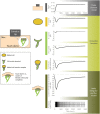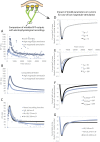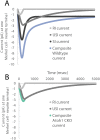Computation predicts rapidly adapting mechanotransduction currents cannot account for tactile encoding in Merkel cell-neurite complexes
- PMID: 29958280
- PMCID: PMC6042796
- DOI: 10.1371/journal.pcbi.1006264
Computation predicts rapidly adapting mechanotransduction currents cannot account for tactile encoding in Merkel cell-neurite complexes
Abstract
Distinct firing properties among touch receptors are influenced by multiple, interworking anatomical structures. Our understanding of the functions and crosstalk of Merkel cells and their associated neurites-the end organs of slowly adapting type I (SAI) afferents-remains incomplete. Piezo2 mechanically activated channels are required both in Merkel cells and in sensory neurons for canonical SAI responses in rodents; however, a central unanswered question is how rapidly inactivating currents give rise to sustained action potential volleys in SAI afferents. The computational model herein synthesizes mechanotransduction currents originating from Merkel cells and neurites, in context of skin mechanics and neural dynamics. Its goal is to mimic distinct spike firing patterns from wildtype animals, as well as Atoh1 knockout animals that completely lack Merkel cells. The developed generator function includes a Merkel cell mechanism that represents its mechanotransduction currents and downstream voltage-activated conductances (slower decay of current) and a neurite mechanism that represents its mechanotransduction currents (faster decay of current). To mimic sustained firing in wildtype animals, a longer time constant was needed than the 200 ms observed for mechanically activated membrane depolarizations in rodent Merkel cells. One mechanism that suffices is to introduce an ultra-slowly inactivating current, with a time constant on the order of 1.7 s. This mechanism may drive the slow adaptation of the sustained response, for which the skin's viscoelastic relaxation cannot account. Positioned within the sensory neuron, this source of current reconciles the physiology and anatomical characteristics of Atoh1 knockout animals.
Conflict of interest statement
The authors have declared that no competing interests exist.
Figures





Similar articles
-
Mechanotransduction in epidermal Merkel cells.Pflugers Arch. 2015 Jan;467(1):101-8. doi: 10.1007/s00424-014-1569-0. Epub 2014 Jul 23. Pflugers Arch. 2015. PMID: 25053537 Free PMC article. Review.
-
Piezo2 is required for Merkel-cell mechanotransduction.Nature. 2014 May 29;509(7502):622-6. doi: 10.1038/nature13251. Epub 2014 Apr 6. Nature. 2014. PMID: 24717433 Free PMC article.
-
Epidermal Merkel cells are mechanosensory cells that tune mammalian touch receptors.Nature. 2014 May 29;509(7502):617-21. doi: 10.1038/nature13250. Epub 2014 Apr 6. Nature. 2014. PMID: 24717432 Free PMC article.
-
Piezo2 is the major transducer of mechanical forces for touch sensation in mice.Nature. 2014 Dec 4;516(7529):121-5. doi: 10.1038/nature13980. Nature. 2014. PMID: 25471886 Free PMC article.
-
Merkel cells and neurons keep in touch.Trends Cell Biol. 2015 Feb;25(2):74-81. doi: 10.1016/j.tcb.2014.10.003. Epub 2014 Dec 2. Trends Cell Biol. 2015. PMID: 25480024 Free PMC article. Review.
Cited by
-
An elasticity-curvature illusion decouples cutaneous and proprioceptive cues in active exploration of soft objects.PLoS Comput Biol. 2021 Mar 22;17(3):e1008848. doi: 10.1371/journal.pcbi.1008848. eCollection 2021 Mar. PLoS Comput Biol. 2021. PMID: 33750948 Free PMC article.
-
How Merkel cells transduce mechanical stimuli: A biophysical model of Merkel cells.PLoS Comput Biol. 2023 Dec 20;19(12):e1011720. doi: 10.1371/journal.pcbi.1011720. eCollection 2023 Dec. PLoS Comput Biol. 2023. PMID: 38117763 Free PMC article.
-
Uncovering the Cells and Circuits of Touch in Normal and Pathological Settings.Neuron. 2018 Oct 24;100(2):349-360. doi: 10.1016/j.neuron.2018.10.019. Neuron. 2018. PMID: 30359601 Free PMC article. Review.
-
Subtle Contact Nuances in the Delivery of Human-to-Human Touch Distinguish Emotional Sentiment.IEEE Trans Haptics. 2022 Jan-Mar;15(1):97-102. doi: 10.1109/TOH.2021.3137833. Epub 2022 Mar 18. IEEE Trans Haptics. 2022. PMID: 34941520 Free PMC article.
-
Temporal coherency of mechanical stimuli modulates tactile form perception.Sci Rep. 2021 Jun 3;11(1):11737. doi: 10.1038/s41598-021-90661-1. Sci Rep. 2021. PMID: 34083558 Free PMC article.
References
-
- Johnson K. The roles and functions of cutaneous mechanoreceptors. Current Opinion in Neurobiology. 2001. August 1;11(4):455–61. - PubMed
Publication types
MeSH terms
Associated data
Grants and funding
LinkOut - more resources
Full Text Sources
Other Literature Sources

